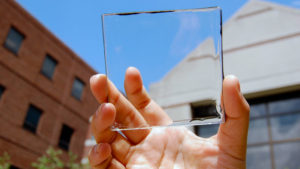
A solar window created by scientists at Michigan State University in East Lansing reached an efficiency of 5% using organic photovoltaics. Richard Lunt/Michigan State University
Lance Wheeler looks at glassy skyscrapers and sees untapped potential. Houses and office buildings, he says, account for 75% of electricity use in the United States, and 40% of its energy use overall. Windows, because they leak energy, are a big part of the problem. “Anything we can do to mitigate that is going to have a very large impact,” says Wheeler, a solar power expert at the National Renewable Energy Laboratory in Golden, Colorado.
A series of recent results points to a solution, he says: Turn the windows into solar panels. In the past, materials scientists have embedded light-absorbing films in window glass. But such solar windows tend to have a reddish or brown tint that architects find unappealing. The new solar window technologies, however, absorb almost exclusively invisible ultraviolet (UV) or infrared light. That leaves the glass clear while blocking the UV and infrared radiation that normally leak through […]











